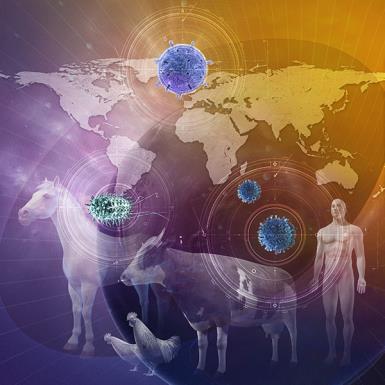Although only a minority of veterinarians report primary public health employment, virtually all veterinarians contribute to the overall public health effort. Public health can be defined as the totality of all evidence-based public and private efforts that preserve and promote health and prevent disease, disability, and death.
Public Health

-
Public Health Primer
-
-
-
Role of the Veterinarian in Public Health/One Health
- Diagnosis, Surveillance, Epidemiology, Control, Prevention, and Elimination of Zoonotic Diseases:
- Management of Health Aspects of Laboratory Animal Facilities and Diagnostic Laboratories:
- Biomedical Research:
- Health Education and Extension:
- Production and Control of Biologic Products and Medical Devices:
- Government/Legislative Activity:
- Significant National Public Health Achievements
- National Public Health Indicators
- Essential Public Health Functions
- Public Health Foci of Prevention
-
Basic Principles of Epidemiology
-
-
Incidence and Impact of Foodborne Diseases
- Role of Food Animal Veterinarians in Control of Foodborne Pathogens
-
-
- Primary Sources of State Public Health Authority
-
Selected General Federal Emergency Legal Authorities
- Homeland Security Act of 2002:
- Robert T. Stafford Disaster Relief and Emergency Assistance Act of 1988:
- National Emergencies Act:
- Emergency Management Assistance Compact (EMAC) of 1996:
- Public Health Service Act:
- Executive Order 13295 (Amended): Revised List of Quarantinable Communicable Diseases:
- Interstate Quarantine (42 CFR, Part 70):
- Pandemic and All-Hazards Preparedness Act of 2006:
- Social Security Act: Authority to Waive Requirements During National Emergencies:
- Public Readiness and Emergency Preparedness Act of 2005:
- Emergency Use Authorization:
- Pandemic and All-Hazards Preparedness Reauthorization Act of 2013:
- Volunteer Protection Act of 1997:
- Posse Comitatus Act of 1878:
- Insurrection Act of 1807:
- Zooeyia
-
Public Health Sections (A-Z)
Public Health Primer
Although only a minority of veterinarians report primary public health employment, virtually all veterinarians contribute to the overall public health effort. According to the World Health Organization, “health is a state of complete physical, mental and social well-being and not merely the absence of disease or infirmity.” Public health can be defined as the totality of all evidence-based public and private efforts that preserve and promote health and prevent disease, disability, and death. The concept of One Health is the collaborative effort of multiple health science professions, together with their related disciplines and institutions—working locally, nationally, and globally—to attain optimal health for people, domestic animals, wildlife, plants, and our environment.
Zoonoses
Zoonotic diseases present challenges not only to veterinarians but also to all professions concerned with public health. Cooperation between veterinarians and public health physicians has been an important factor in zoonosis control programs. An example of this collaboration is the eradication of bovine tuberculosis, first in Denmark, Sweden, Finland, and Norway, and then in the USA, Canada, and other countries. Unfortunately, some zoonoses that are well controlled in developed nations, such as bovine and porcine brucellosis, bovine tuberculosis, and rabies, remain major problems in the developing world. Diseases can also reemerge in areas where they have been eradicated. Newly recognized zoonotic organisms such as Hendra and Nipah viruses are emerging, and many other zoonoses remain a constant concern.
Also of Interest
Test your knowledge
Foodborne pathogens have similar nutritional and environmental requirements that affect their ability to multiply. Food handlers can control these aspects to limit pathogen growth. For example, pathogens grow best when the temperature is 40°F and 140°F. In general, perishable foods should not be kept in this danger zone for more than how many hours?




